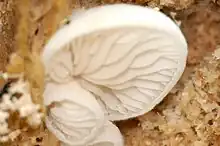| Crepidotus cesatii | |
|---|---|
 | |
| Scientific classification | |
| Domain: | Eukaryota |
| Kingdom: | Fungi |
| Division: | Basidiomycota |
| Class: | Agaricomycetes |
| Order: | Agaricales |
| Family: | Crepidotaceae |
| Genus: | Crepidotus |
| Species: | C. cesatii |
| Binomial name | |
| Crepidotus cesatii (Sacc. 1877)[1] | |
| Synonyms[2] | |
| |
Crepidotus cesatii, commonly known as the roundspored oysterling, is a species of saprophytic fungus in the family Crepidotaceae with a stipeless sessile cap. It is often found on woody and herbaceous plant debris from many different hosts including conifers, appearing from late summer to winter usually in small scattered groups. Often confused with Crepidotus variabilis, it can be distinguished by its different spores.[3]
Description
- Cap: The cap (pileus) of C. variabilis is generally about 0.4 to 2 cm in diameter is white and emerges kidney shaped soon becoming irregular and wavy forming patches of overlapping fruit bodies. The surface is very finely downy to velvety with a margin more or less inrolled.[3]
- Gills: Colour is whitish, then buff-brown with pink flush, fairly distant, decurrent to base.[3]
- Spores: The spore print is pinkish-buff, more pink than C. variabilis. Their shape is subspherical and minutely warty, measuring 6.5–8.5 × 5–7 µm in size.[3]
- Absent features: No stipe (stem) or annulus (ring).
| Crepidotus cesatii | |
|---|---|
| Gills on hymenium | |
| Lacks a stipe | |
| Spore print is buff | |
References
- ↑ Sylloge Fungorum 5: 879 (1887) [MB#191614]
- ↑ Crepidotus cesatii in MycoBank.
- 1 2 3 4 Buczacki, Stefan; Shields, Chris; Ovenden, Denys (2012). "Crepidotus cesatii". Collins Fungi Guide. London: Harper Collins. ISBN 9780007466481.
Bibliography
- Saccardo, P.A. 1887. Sylloge Hymenomycetum, Vol. I. Agaricineae. Sylloge Fungorum. 5:1-1146
Wikimedia Commons has media related to Crepidotus cesatii.
This article is issued from Wikipedia. The text is licensed under Creative Commons - Attribution - Sharealike. Additional terms may apply for the media files.